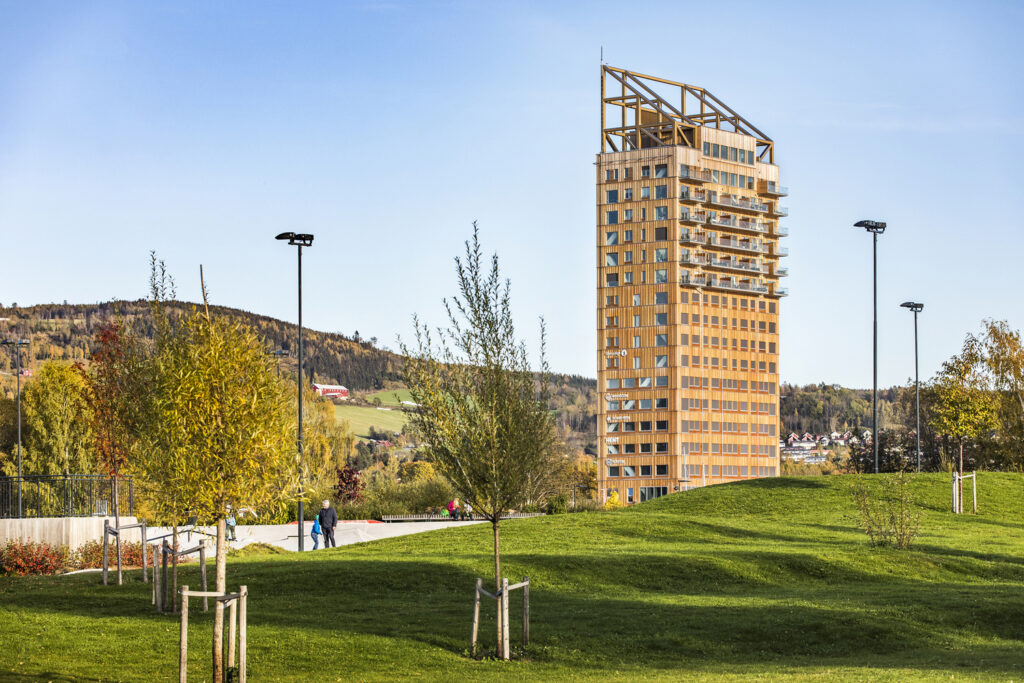Introduction to Mass Timber
It is more than just wood. It’s a revolutionary building material reshaping skylines around the world. Picture this: layers of wood, bonded together to create something extraordinarily strong and stunningly beautiful. This isn’t your grandfather’s log cabin; it’s high-tech, sustainable, and changing the face of modern architecture.
What is Mass Timber?
It refers to large, prefabricated wooden panels used as structural elements in building construction. These panels are made from several layers of wood stacked crosswise and glued together, enhancing their strength and stability. This method allows for quick assembly and disassembly, making construction projects faster, less noisy, and cleaner.
A Quick Dive into History of Mass Timber
The use of timber in construction is ancient, but “mass” timber began turning heads in the 1990s with technological advances in wood processing. Since then, it’s been a cornerstone in eco-friendly construction, championing a return to one of humanity’s oldest building materials—but with a modern twist.
Types of Mass Timber
Mass timber can come in various forms, each with unique characteristics and applications. Here’s a breakdown to get you acquainted with the timber family:
| CLT (Cross-Laminated Timber) | Multi-layered panels made by gluing layers of solid wood at perpendicular angles. | Floors, walls, roofs. |
| Glulam (Glue-Laminated Timber) | Beams made by gluing layers of timber with the grain running parallel. | Beams, columns, bridges. |
| NLT (Nail-Laminated Timber) | Panels created by stacking boards on edge and fastening them together with nails. | Floor and roof decking. |
| DLT (Dowel-Laminated Timber) | Panels made by friction-fitting wood dowels into pre-drilled holes without glue. | Roofs, floors, walls. |
Each type brings a different flavor to the construction table, providing architects and builders with a smorgasbord of options for designing everything from cozy homes to towering skyscrapers.
Mass Timber Manufacturing Process
The journey from tree to towering timber begins in the forest but quickly moves into the high-tech world of industrial manufacturing.
The Making of Mass Timber
- Selection: It starts with selecting the right type of wood, typically softwoods like spruce, pine, or fir, known for their strength and flexibility.
- Processing: The wood is then cut, dried, and treated to ensure uniform quality and durability.
- Layering: For products like CLT, the wood is layered in alternating directions, glued, and pressed under immense pressure to create robust panels.
- Finishing: Finally, these panels are precision-cut to spec, ready to become part of buildings that are as sturdy as they are stunning.
Technological Enhancements
Modern mass timber isn’t just wood. It’s a feat of engineering, with each panel crafted to maximize strength, minimize waste, and support sustainable building practices. Computer-controlled cutting ensures pinpoint accuracy, while advanced adhesives and treatments boost durability and fire resistance.
Structural Properties and Benefits
Mass timber isn’t just another building block. It’s a powerhouse in architectural design and construction, bringing a blend of strength, flexibility, and environmental benefit that traditional materials can hardly match. Let’s break down why builders and architects are turning to this mighty material.
Strength and Durability
Imagine a material that can stand toe-to-toe with concrete and steel but is lighter and easier to work with. Thanks to its engineered properties, mass timber delivers a strength-to-weight ratio that makes it perfect for both low-rise buildings and soaring skyscrapers.
Load-bearing Capabilities
Mass timber’s load-bearing prowess is not just about holding up floors and roofs; it’s about opening up possibilities. With fewer columns needed, spaces become more open and adaptable, offering architects more creative freedom in design. The structural integrity of it supports a variety of architectural forms and sizes, enabling designs that were once difficult to achieve.
Mass Timber Fire Resistance and Safety
When it comes to fire, mass timber has a secret weapon: it chars. This might sound counterintuitive, but charring actually protects the core of the timber, maintaining the structural integrity longer than many expect.
Understanding Fire Resistance
Mass timber’s ability to char at a predictable rate allows it to maintain its strength during a fire, providing critical extra minutes for evacuation and emergency response. Unlike steel, which can buckle and collapse under intense heat, mass timber remains stable, offering a robust fire resistance that is rigorously tested and proven under international building codes.
Safety Standards and Compliance
Adhering to stringent safety standards, mass timber buildings are designed with fire safety in mind. Innovations in building techniques and materials, like fire-retardant treatments and automatic fire suppression systems, enhance the inherent safety features of mass timber, making it a safe choice for residential and commercial construction.
Sustainability and Environmental Impact
Mass timber is touted as a champion of sustainable construction, and for good reason. Its use tackles some of the most pressing environmental issues facing the construction industry today.
Mass Timber Carbon Sequestration Capabilities
Trees naturally absorb CO2 from the atmosphere, locking it away as carbon in their wood. When used in construction, this carbon is effectively sequestered in the structure of buildings, potentially for decades or even centuries. Mass timber extends the lifecycle of this stored carbon, contrary to traditional building materials like steel or concrete, which require high levels of CO2 emissions for production. The longer a building stands, the longer its carbon is kept out of the atmosphere.
A Lower Carbon Footprint
Mass timber promotes a lower carbon footprint in multiple ways. It is derived from a renewable resource—forests—that can be replanted and regrown, ensuring a sustainable supply chain. The manufacturing process of mass timber products also typically requires less energy compared to steel or concrete, leading to reduced overall emissions. Furthermore, the lightweight nature of it reduces transportation emissions, and its ease of assembly cuts down on construction-related energy use.
Economic Considerations
Beyond its environmental benefits, mass timber also presents compelling economic advantages that make it an appealing choice for developers and investors alike.
Cost-effectiveness and Market Trends
Mass timber can be surprisingly cost-effective. Its prefabricated nature speeds up construction times dramatically, slashing labor costs and reducing the overall time frame of projects. Faster construction means quicker turnover, which is a significant financial boon for commercial developers. Moreover, as the demand for sustainable building materials rises, the market for mass timber is expected to grow, potentially lowering costs further through economies of scale.
Mass Timber Potential for Cost Savings
The initial costs of mass timber may be higher than traditional materials on a per-unit basis, but the total project costs often tell a different story. The efficiency of this material construction reduces the need for an extensive on-site workforce and can decrease the overall project timeline, which translates into savings on general conditions and other time-related costs. Additionally, the durability and low maintenance requirements of it structures can lead to lower long-term costs for building owners.
Architectural and Design Flexibility
The flexibility and aesthetic appeal of mass timber have sparked a new wave of creativity in architecture, allowing for innovations in both form and function.
Aesthetic Benefits and Design Versatility
Mass timber brings a natural, warm aesthetic that can’t be matched by concrete or steel. This visual appeal is a significant selling point in residential and commercial spaces where the look and feel of the environment are crucial. Beyond beauty, mass timber’s versatility allows for intricate designs that are tough to achieve with other materials. Its ability to be precision-cut and molded into nearly any shape gives architects the freedom to innovate and push the boundaries of traditional designs.
Hybrid Construction Techniques
The integration of mass timber with other building materials, such as steel and concrete, is a trend on the rise. This hybrid approach leverages the best properties of each material to enhance building performance and sustainability.
Integrating Mass Timber with Other Materials
Hybrid construction techniques often combine the lightness and environmental benefits of wood with the strength and fire resistance of steel or the acoustic and thermal properties of concrete. This method allows for greater spans, enhanced structural integrity, and improved building performance. For example, incorporating steel connectors in a mass timber frame can enhance its seismic resilience, making it suitable for earthquake-prone areas.
Benefits and Challenges of Hybrid Systems
The benefits of hybrid construction include enhanced structural capabilities and the potential for more significant architectural freedom. However, the challenges lie in the complexity of design and the need for specialized knowledge in combining these materials effectively. The success of such projects depends on meticulous planning and collaboration between architects, engineers, and builders to ensure that the structural and aesthetic qualities of the building are optimized.
Case Studies
The practical applications of mass timber are as diverse as they are impressive. By examining specific case studies, we can see how it is not only a viable option but a superior one in various construction contexts.
Notable Buildings and Structures Worldwide
Mass timber has been utilized in landmark projects around the globe, each demonstrating unique aspects of its potential. For instance, the Mjøstårnet in Norway, currently one of the tallest timber buildings in the world, exemplifies the material’s strength and viability for high-rise construction. Another example, the Catalyst Building in Spokane, Washington, showcases mass timber’s role in creating sustainable and energy-efficient educational spaces.
Lessons Learned and Insights
Each project completed contributes valuable lessons to the broader construction industry. Key insights include the importance of early collaboration among architects, engineers, and contractors to address any design and material handling challenges. Additionally, these case studies often highlight the efficiency gains during the construction phase, thanks to prefabricated mass timber elements which shorten the overall project timelines and reduce labor costs.
Regulations and Code Developments
The adoption of mass timber is closely tied to the evolving landscape of building regulations and codes, which can either accelerate or hinder its growth.
Overview of Changes in Building Codes
In recent years, many regions have updated their building codes to accommodate the use of mass timber, recognizing its safety and sustainability benefits. For example, changes to the International Building Code (IBC) in 2021 have allowed for the construction of taller mass timber buildings up to 18 stories, previously capped at just a few stories. These regulatory shifts are crucial for the expansion of this material in urban and suburban developments.
Impact on the Adoption of Mass Timber
As building codes continue to evolve, the rate of mass timber adoption is expected to increase, fostering more innovative and sustainable building practices. These changes not only promote the use of mass timber but also ensure that it meets strict safety and performance standards, making it a more attractive option for developers and investors.
Conclusion
With its impressive structural properties, environmental benefits, and aesthetic versatility, it offers a sustainable alternative to traditional building materials like steel and concrete. The growing body of case studies and evolving regulations are testaments to its potential, paving the way for a future where mass timber is a cornerstone of modern architecture. As we continue to explore and embrace mass timber, we can look forward to a world where our buildings are not only made from the best materials nature has to offer but also contribute to the health of our planet.
If you want o learn about our consultancies in Portuguese language, click here.
The post Exploring Mass Timber: Innovations, Sustainability, and Future Trends in Construction appeared first on UGREEN.




